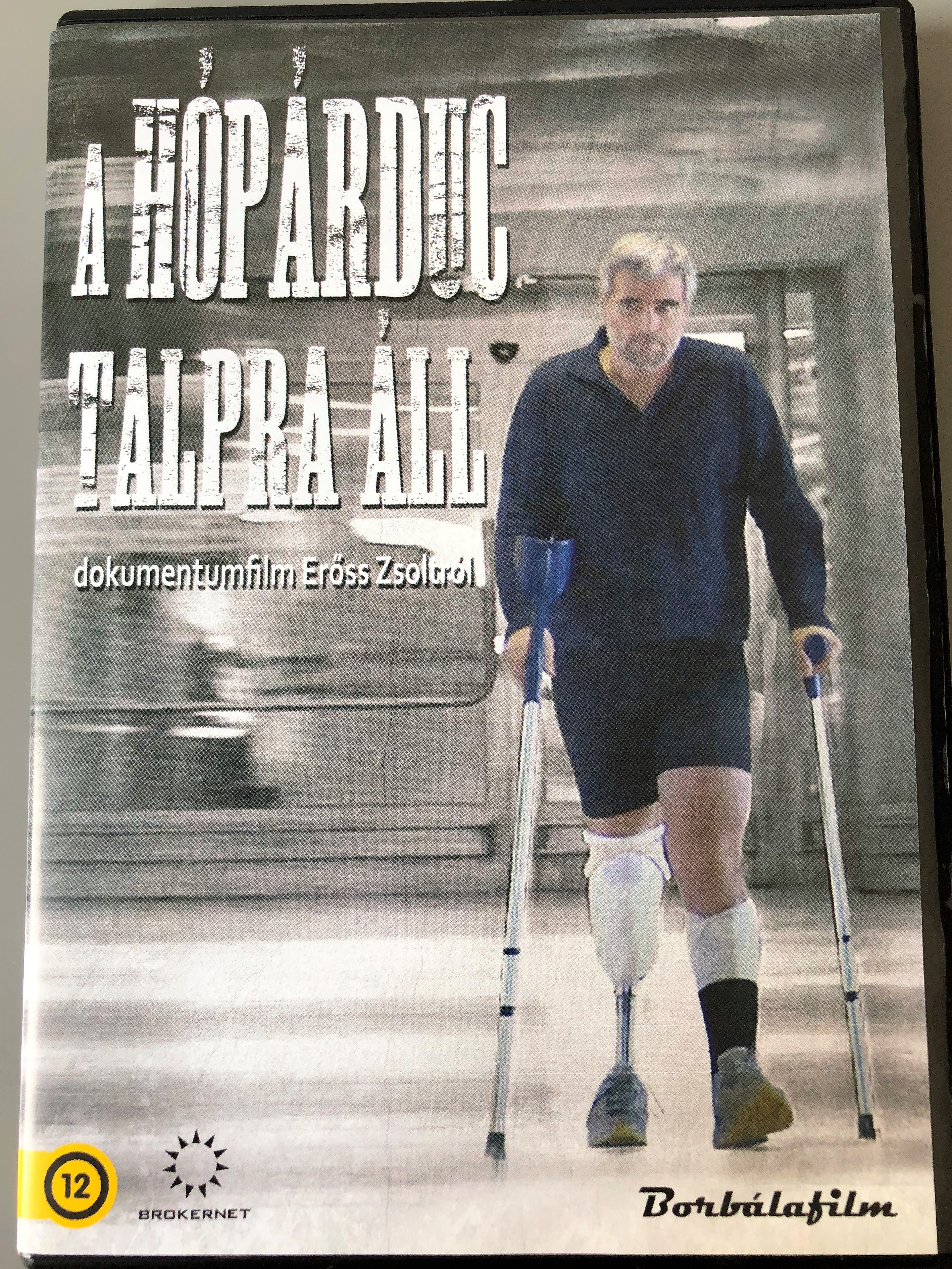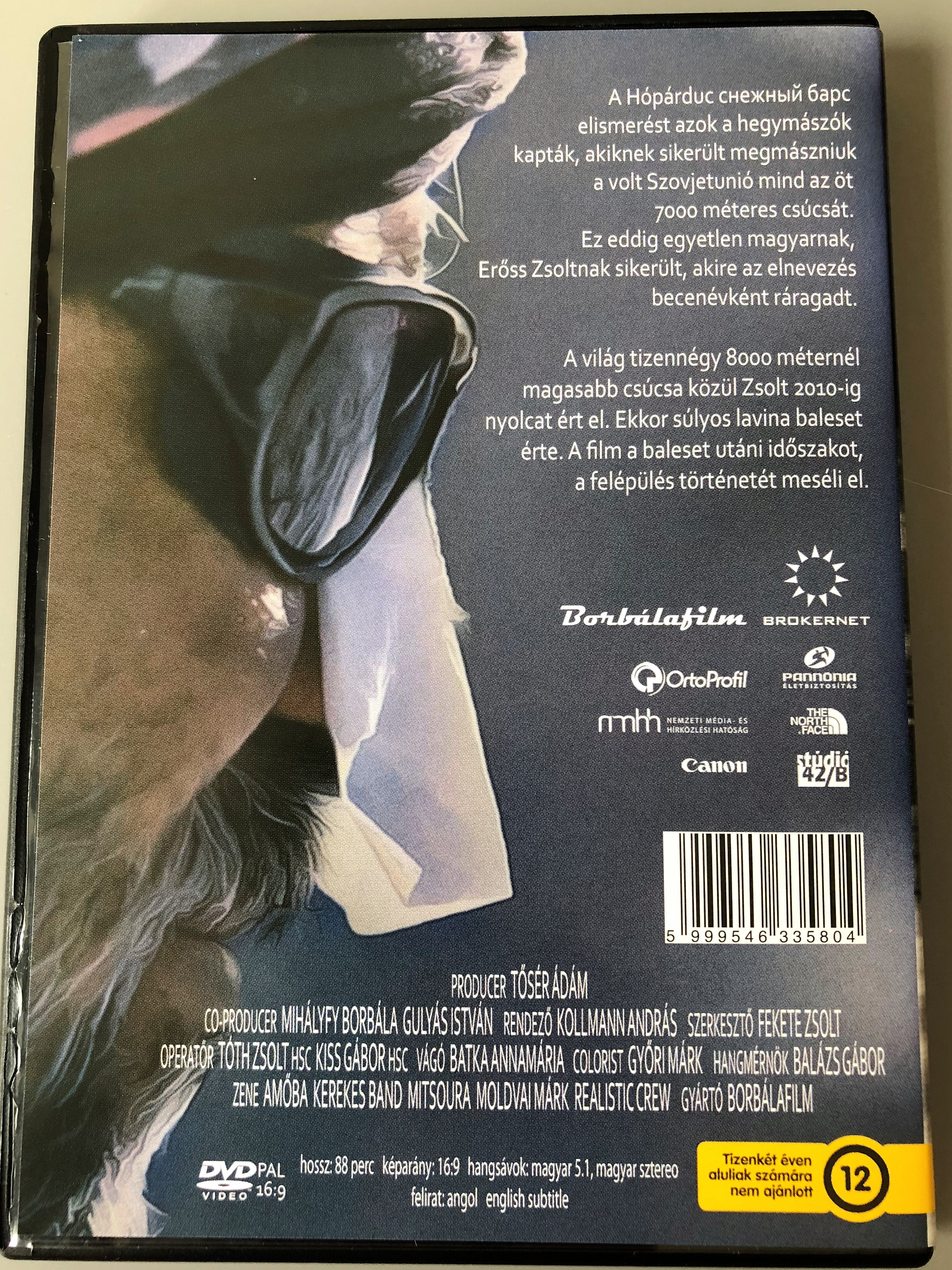Description
A hópárduc talpra áll DVD / Snow Leopard Gets Back on His Feet / Dokumentumfilm Erőss Zsoltról / Director: Kollmann András / Fantasy Film / Hungarian Audio / English Subtitle
UPC 5999546335804
Élhet-e az ember fél lábbal is teljes életet?
2010. január 2-án Erőss Zsolt, a legeredményesebb magyar hegymászó lavinabalesetet szenved a Magas-Tátrában, melynek következtében jobb lábát amputálni kell. Zsolt már a kórházi ágyán elhatározza, hogy szeptemberben ismét nekivág a Himalájának, hogy egy újabb 8000 méter fölötti csúcsot meghódítson. A stáb végigkíséri Zsolt felépülését az első kórházi járáskísérletektől kezdve egészen az expedícióig, hogy bemutassa azt az emberfeletti küzdelmet, amivel Zsolt vissza szeretne térni a hegyek világába, és újra teljes életet élni.
A Hópárduc elismerést azok a hegymászók kapták, akiknek sikerült megmászniuk a volt Szovjetunió mind az öt 7000 méteres csúcsát. Ez eddig egyetlen magyarnak, Erőss Zsoltnak sikerült, akire az elnevezés becenévként ráragadt.
A világ tizennégy 8000 méternél magasabb csúcsa közül Zsolt 2010-ig nyolcat ért el. Ekkor súlyos lavina baleset érte. A film a baleset utáni időszakot, a felépülés történetét meséli el.
The Snow Leopard award (Russian: Снежный барс) was a Soviet mountaineering award, given to very experienced climbers. It is still recognised in the Commonwealth of Independent States. To receive this award, a climber must summit all five peaks of 7000m and above located in the former Soviet Union.
Zsolt Erőss (March 7, 1968 – May 21, 2013) was the most successful Hungarian high-altitude mountaineer,summiting 10 out of the 14 eight-thousanders. He was also the first Hungarian citizen to have climbed Mount Everest.
In 2010, he lost his right leg in an avalanche accident, requiring amputation below the knee. Soon after his recovery he returned to mountaineering, trying to summit the Cho Oyu in fall 2010. The expedition did not reach the top due to bad weather conditions, but later in May 2011 he successfully summited the Lhotse. After successfully scaling Kangchenjunga on May 20, 2013, he went missing in descent. Search missions were suspended on May 22. According to the expedition's leader and other experienced mountaineers, his survival is impossible.
Climbed Eight-thousanders
- 1999 - Nanga Parbat 8126 m in a new route (solo climb of the Mummery Rib, the glacier that lies between Ganalo Peak and Nanga Parbat)
- 2002 - Everest 8848 m
- 2003 - Gasherbrum II 8035 m
- 2006 - Dhaulagiri 8167 m
- 2007 - Hidden Peak 8068 m
- 2007 - Broad Peak 8047 m
- 2008 - Makalu 8481 m
- 2009 - Manaslu 8156 m
- 2011 - Lhotse 8516 m (with prosthetic leg)
- 2013 - Kangchenjunga 8586 m (with prosthetic leg)
Other notable climbs
- 1990 - Elbrus 5642 m
- 1991 - Khan Tengri 6995 m, Pobeda peak 7439 m
- 1993 - Lenin Peak 7134 m
- 1994 - Pik 4 in Pamir Mountains 6400 m, Korzhenevskaya 7105 m, Communism Peak 7495 m, unnamed peak at 6200 m in Pamir, Tajikistan
- 1995 - attempt: Ogre (reached 7000 m)
- 1996 - 2 attempts for Everest (reached 8300 m)
- 1997 - south face of Satopanth until 7050 m
- 1999 - Ganalo Peak 6606 m
- 2000 - Distaghil Sar 7885 m, in new route
- 2001 - Aconcagua 6960 m
- 2003 - attempt for Hidden Peak in a new route (reached 8000 m)
- 2004 - Kilimanjaro 5895 m
- 2005 - attempt: K2 (reached 8300 m)
- 2010 - attempt: Cho-Oyu (reached 7100 m, with prosthetic leg)
- 2012 - attempt: Annapurna I (reached 7400 m, with prosthetic leg)
Disappearance
On May 20, 2013, 18:00 he successfully summited Kangchenjunga together with his climbing partner, 26-year-old Péter Kiss. During the descent Erőss reported feeling weak and showed signs of exhaustion, falling behind by the rest of the summiteers. He spent the night presumably alone in the death zone but in the morning he was joined by Kiss, who in a highly unusual move climbed back up to help his partner, as reported around 9 am. They were seen descending slowly towards Camp 4, situated at 7600 m, but soon after Kiss fell and disappeared. Erőss' condition deteriorated rapidly, reporting vision problems, being unaware of Kiss' whereabouts and finally speaking incoherently. He sat down and slept a few hours, after which around 3:00 pm he reported feeling better and seemed to get back his strength to start moving down to Camp 4. Along the way he went missing, and was never seen again. Members of a Korean expedition, who also lost one of their members, attempted to search for both Erőss and Kiss but only Kiss' body could be spotted.
On May 22, it was announced that search for the climbers had been abandoned.


In Tajikistan's Pamir Mountains there are three Snow Leopard peaks, Ismail Samani Peak (formerly Communism Peak) 7,495 m (24,590 ft), Peak Korzhenevskaya 7,105 m (23,310 ft), and Ibn Sina Peak (formerly Lenin Peak) 7,134 m (23,406 ft) on the Kyrgyzstan-Tajikistan border. In the Tian Shan there are two Snow Leopard peaks, Jengish Chokusu (formerly Peak Pobeda) 7,439 metres (24,406 ft) in Kyrgyzstan (divided by the border with China), and Khan Tengri 7,010 m (22,998 ft) on the Kyrgyzstan-Kazakhstan border.
Khan Tengri's geologic elevation is 6,995 m (about 22,950 ft.) but its glacial cap rises to 7,010 m. For this reason, it is considered a 7000m peak.





















